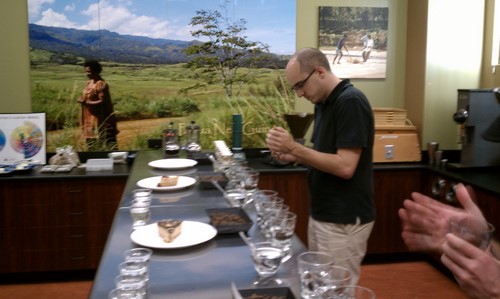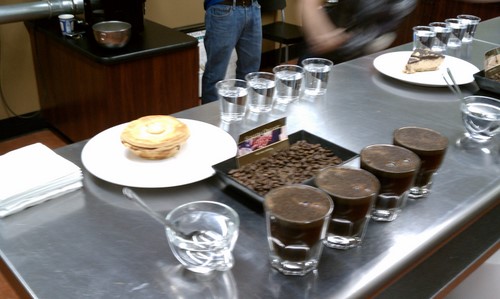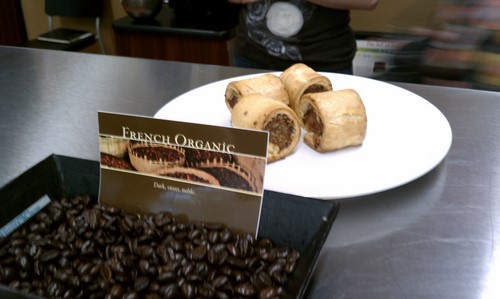Thursday morning I had the pleasure of visiting Portland Roasting Company (PRC) to take part in the company’s “Cupping for the People.” This is a free event that PRC puts on once a month to educate people about its coffee and roasting operations. I tried to go last month, but the class was already full, so I had to wait. The wait was worth it and I had another great day of coffee education.
Nathanael May, PRC’s coffee educator and trainer, was our guide for the day. Only three of us were there to participate—apparently several people had cancelled. It was their loss, as we had a very interesting and tasty morning. The first thing we did was take a tour of the warehouse and roasting facility. PRC is located in the building of a former bulk popcorn producer (I didn’t know such companies existed, but then again, maybe they don’t, which could be why PRC has this space).
Nathanael explained that the facility was a good fit because it included both food storage and production areas. As we passed through the warehouse, we could see that here were hundreds of boxes of Muin syrups on the shelf (PRC is the nationwide distributor for the syrup maker). At the back of the warehouse, there were large jute sacks of coffee piled high, each bearing the name of a country or growing region. Coffees from Asia, Central and South America and Africa were all present .
In addition to the regular coffees, there was also a small section of coffee that was labeled “Swiss Water”. Contrary to what you might think, Swiss Water is not some exotic coffee from northern Europe. Rather, it is the name of the method that Portland Roasting uses to decaffeinate its coffee.
Nathanael explained that there are two main methods than can be used for the decaffeinating process. The first is chemical decaffeination, which usually involves spraying ethyl acetate, or some other solvent, onto the coffee. The caffeine binds to the solvent, then is evaporated off, taking the caffeine with it.
PRC wants to use as few chemicals in producing its coffee as possible, so the company puts its coffee through the Swiss Water process. The Swiss Water process submerges the green coffee in hot water, which releases the caffeine (and other flavor compounds). The water is then passed through a special filter that removes 99.9% of the caffeine. The water, which still has the flavor compounds, is circulated back to the beans and then evaporated so that the beans can regain their flavors. Interestingly enough, all of the coffee processed this way is processed by one company in Vancouver, Canada (you can read more about the process here).
After checking out the warehouse, we went into the roasting area. Nathanael explained how the roasting process works. The green coffee is lifted using air pressure into the hopper above the roaster, removing bits of foreign material that could be in the coffee. When the roaster has reached a certain temperature, the coffee drops into the rotating drum, where it takes about ten minutes to roast. Roasters monitor the coffee closely, ensuring that it is roasted just right.
The roasters know the coffee is ready based on how it smells, but color is also an important indicator of quality. To make sure that the color is just right, PRC relies on the roaster’s eyes, but also on a machine that bounces UV light off the coffee and precisely measures the reflected light. By making sure over time that colors are consistent, the roasters know that the coffee is likely to have the taste profile that they are looking for.
When the coffee is ready, it is dumped into the cooling bins, where large paddles slowly swirl it around. A vacuum system pulls cool air across the coffee through holes in the bottom of the bin. It is important to cool the coffee quickly, or the hot coffee will continue to roast itself, resulting in over-roasted coffee. Some of the large commercial roasters actually spray a mist of cool water onto the coffee at this point. This is very effective, but it introduces the moisture into the coffee, making it more likely that mold or mildew will form on the coffee. Therefore, PRC only uses air.
Once we had a rundown of the roasting operation, it was time to head to the tasting room for the actual “cupping.” Nathanael explained the process to us, and we were joined for this part of the tour by several PRC employees.
Cupping is the standard industry method for tasting and grading coffee. Originally, the process was designed to help commodity coffee buyers find defects in any green coffee they were considering purchasing. As they found defects, they could justify offering lower prices. Over the years, use of the technique has expanded, and it is no longer used only to find defects. There are competitions where multiple roasters’ coffees are “cupped” and the best coffees receive the “Cup of Excellence” designation.
We cupped four different coffees: an organic coffee from Sumatra, one from Colombia, one from Ethiopia Yirgacheffe and the Portland Roasting’s French Roast. Each type of coffee, was ground and measured out into four glass cups (except for the French roast, which was ground into French presses). Thus, there were twelve glass cups plus two French presses set out on the table. The first step was to smell the coffee to see what fragrances we could pick up. We gave each cup (all twelve) a small tap to stir up the fragrances, and breathed deeply with our noses next to the top of the cup.
 Nathanael, leading the way
Nathanael, leading the way
“If you say that each one just smells like coffee, that’s fine,” Nathanael explained, “but you will probably notice that there are some differences between the coffees, even if you can’t say exactly what.”
After smelling the coffee, hot water is poured over the grounds in each cup and you let it sit for four minutes. The grounds float to the top of the cup, forming a crust. As the coffee sits there, you smell each of the four cups of each coffee again. You smell each cup so that you can really imprint the aromas on your sensory memory.
The third step, which is my favorite step, is the “breaking of the crust.” As the coffee sits in the cup, the aromatic compounds that give coffee its unique flavors are trapped beneath the crust. Using the spoon, you gently insert about half the spoon into the grounds and gently push forward an pull backward along the surface of the cup, keeping your nose right next to the cup so that you can catch the aromas as they escape into the air. I like this step the best because the aromas are extra intense at this point and they smell wonderful! Each person breaks one crust of each coffee.
 Crusts, waiting to be broken
Crusts, waiting to be broken
After breaking the crust, Nathanael and Stephanie, PRC’s coffee buyer who had joined us, carefully removed the remaining foam on top of the cup. The clean coffee beneath was ready for “slurping,” which is the actual tasting process. To slurp, you partly fill the spoon with coffee and slurp it up into your mouth trying to make as much noise as possible. Slurping sprays the coffee across the palate and helps you identify where the coffee flavors hit on your tongue. I find this part fun, but still have a hard time picking up the subtleties. The Sumatra was supposed to be earthy and spicy, the Colombia nutty, the Ethiopia berry-like and the French smoky. The earthiness of the Sumatra and the smokiness of the French were the two most obvious flavors for me.
In order to help us better detect the flavors, PRC arranged some food pairings for the second round of slurping. Sarah, the owner of Pacific Pie Company, brought four different treats for us to try with the coffee. She brought a beef and mushroom pie to bring out the spice and earthiness in the Sumatra, a peanut butter and chocolate pie for the nuttiness of the Colombia, a berry pie for the Yirgacheffe and a sausage wrapped in pastry dough to emphasize the smoky flavors of the French roast. The food was excellent and did help us understand the flavors better. It was a nice addition to the cupping that I had not expected.
 Smoky coffee, smoky sausage. Mmmm...
Smoky coffee, smoky sausage. Mmmm...
After the cupping was over, the group chatted about the Portland coffee scene for a while. Everyone agreed that Portland has very unique and high-quality coffee available. One of the characteristics of the coffee revolution that Portland is leading is that roasters are getting more involved in the communities where they source their coffee. Portland Roasting is probably the industry leader when it comes to doing this, having worked on projects in many different countries through the company’s Farm-Friendly Direct program. One of these projects is a well that they recently dug in a community that will reduce the time that people need for carrying water to their village. This will give kids more time to go to school.
Portland Roasting is also looking for ways to innovate in other areas. PRC has the goal of being the world’s most environmentally friendly coffee company and one of the innovations they came up with is the completely compostable paper cup. Previously, their paper cups were lined with a petroleum-based plastic, but PRC figured out (with a stumble or two along the way) how to create a corn-based biodegradable liner so the cups can be composted.
With its unique story, it is surprising that PRC coffee is not as well-known around Portland (and the Northwest) as say, Stumptown. After all, PRC has been in business since 1996, longer than most Portland coffee companies. One of the biggest reasons is probably that PRC does not have any signature cafés bearing the company’s name. Could one be in the works?
“We’re looking for the right location,” Suzan Strick, PRC’s marketing manager, told me. “It’s something that we [PRC employees] are all hoping becomes a reality.”
I hope so too. It’s not that Portland necessarily needs another coffee shop, but Portland Roasting is a Portland original that deserves a place in the conversation about innovative Portland coffee companies. Having a café would help make sure it gets into the conversation and stays there.